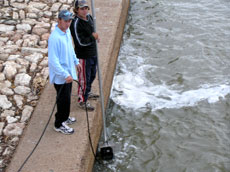
Sonar reveals the secret fears of fish

First Australian trials of a specialist underwater acoustic camera have overcome a major difficulty in fisheries research.
Observation of fishes’ natural behaviour in murky water is now possible, thanks to the dual frequency identification sonar camera, known as a DIDSON.
NSW Department of Primary Industries fisheries scientists say high resolution sonar images from the camera will be invaluable for developing management strategies to protect the long-term survival of fish species.
Hence, there are also implications for the health of inland waterways.
Scientists recently assessed the DIDSON at the mouth of the Murray River where, in 1940, a series of barrages were built across the river at Goolwa.
To restore fish passage up the River, two fish ladders were constructed across the barrages in 2004 by the Murray Darling Basin Commission.
Fisheries researcher Lee Baumgartner said a survey by a research team from NSW, Victoria and South Australia showed the ladders were being used by 19 fish species, but not black bream and mulloway, both iconic species for the region.
DPI trials with the DIDSON showed that black bream “really freak out” when they encountered the fishways, according to Mr Baumgartner.
“They swim up to the ladder, get spooked and then swim away quickly,” he said.

The camera uses sound waves to pick up acoustic echoes of fish swimming and then converts them into digital images, which can be viewed on a personal computer.
Mr Baumgartner said the sonar images show that yellowbelly, bony bream and even small fish like smelt and gudgeon all swim through the fishways. However the black bream won’t.
“We are now using the DIDSON to find out if there is something about the fishway that they do not like. Could it be that the mouth of the ladders is too small for them? Or could the problem be the rapid transition from salt to fresh water?
“The DIDSON will be an invaluable tool in answering these questions.”
DPI recently purchased a DIDSON at a cost of $140,000, after assessing its potential for fisheries research.
Because it is able to observe fish at night and in dirty or turbid water, the DIDSON opens the door for new research directions and ideas for helping migratory fish.
The camera eliminates the need for scientists to physically catch fish to gather information about their biology and ecology, and allows scientists to work with fish non-destructively, without traditional gear like nets or traps.
By directly observing how fish behave when they migrate, feed and spawn, researchers will be better placed to develop management plans to ensure the fishes’ long-term survival.
The technology was first developed in the 1990s by the US Navy to enable divers to detect mines attached to the hull of ships.
Email:

